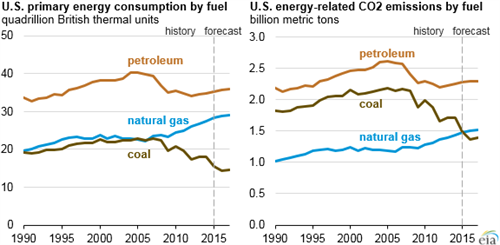EIA: Energy-related CO2 emissions from natural gas surpass coal as fuel use patterns change

Graphic courtesy of the US Energy Information Administration.
According to the US Energy Information Administration (EIA), energy-associated CO2 emissions from natural gas are expected to surpass those from coal for the first time since 1972. Even though natural gas is less carbon-intensive than coal, increases in natural gas consumption and decreases in coal consumption in the past decade have resulted in natural gas-related CO2emissions surpassing those from coal. The EIA's latest Short-Term Energy Outlook projects energy-related CO2 emissions from natural gas to be 10% greater than those from coal in 2016.
From 1990 to about 2005, consumption of coal and natural gas in the United States was relatively similar, but their emissions were different. Coal is more carbon-intensive than natural gas. The consumption of natural gas results in about 52 million metric tons of CO2 for every quadrillion British thermal units (MMmtCO2/quad Btu), while coal's carbon intensity is about 95 MMmtCO2/quad Btu, or about 82% higher than natural gas's carbon intensity.
Because coal has a higher carbon intensity, even in a year when consumption of coal and natural gas were nearly equal, such as 2005, energy-related CO2 emissions from coal were about 84% higher than those from natural gas.
In 2015, natural gas consumption was 81% higher than coal consumption, and their emissions were nearly equal. Both fuels were associated with about 1.5 billion metric tons of energy-related CO2 emissions in the United States in 2015.
Annual carbon intensity rates in the United States have generally been decreasing since 2005. The US total carbon intensity rate reflects the relative consumption of fuels and those fuels' relative carbon intensities. Petroleum, at about 65 MMmtCO2/quad Btu, is less carbon-intensive than coal but more carbon-intensive than natural gas. Petroleum accounts for a larger share of US energy-related CO2 emissions because of its high levels of consumption.
Another contributing factor to lower carbon intensity is increased consumption of fuels that produce no carbon dioxide, such as nuclear-powered electricity and renewable energy. As these fuels make up a larger share of US energy consumption, the US average carbon intensity declines. Although use of natural gas and petroleum have increased in recent years, the decline in coal consumption and increase in non-fossil fuel consumption have lowered US total carbon intensity from 60 MMmtCO2/quad Btu in 2005 to 54 MMmtCO2/quad Btu in 2015.

- Credit Agricole says it will not fund two major LNG projects
- Shareholders’ Resolution: MOL to pay $668-MM dividend
- Aramco awards $7.7-B contracts to add 1.5 Bscfd of raw gas to Fadhili Gas Plant
- Japan's JERA suspends output at 4 gas-fired power plants to secure LNG stocks
- TotalEnergies: Papua LNG project requires 'more work' to reach final investment decision
- Technip Energies awarded a major LNG contract for the North Field South Project by QatarEnergy
- Shell publishes Energy Transition Strategy 2024
- QatarEnergy to charter 19 new LNG vessels expanding fleet further
- Aramco awards $7.7-B contracts to add 1.5 Bscfd of raw gas to Fadhili Gas Plant
- Mabanaft announces successful acquisition of WESTFA Energy GmbH



Comments